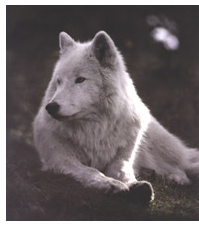If
the wolf is indeed an accurate barometer for the state of our wilderness,
the current situation sends a foreboding message about the threatened
integrity of Ontario's wildlands.
 Few provincial parks and protected areas are of a sufficient size
and quality to sustain viable wolf populations.
Few provincial parks and protected areas are of a sufficient size
and quality to sustain viable wolf populations.
 Wolves have large territories and can easily cover 75 km in just
one day. Researchers have estimated that an area of at least 500
km2 is needed to ensure the long-term viability of a
wolf population.
Wolves have large territories and can easily cover 75 km in just
one day. Researchers have estimated that an area of at least 500
km2 is needed to ensure the long-term viability of a
wolf population.
 There are only 5 protected areas in Ontario where wolf killing is prohibited that are large enough to support a sustainable wolf population. These are: Algonquin Provincial Park, Lake Superior Provincial Park, Chapleau Crown Game Preserve, the Nipissing Crown Preserve and Pukaskwa National Park. There are only 5 protected areas in Ontario where wolf killing is prohibited that are large enough to support a sustainable wolf population. These are: Algonquin Provincial Park, Lake Superior Provincial Park, Chapleau Crown Game Preserve, the Nipissing Crown Preserve and Pukaskwa National Park.
 Only 3% of the province offers a protected sanctuary for wolves;
these areas do not feature snares, bullets or human development.
Only 3% of the province offers a protected sanctuary for wolves;
these areas do not feature snares, bullets or human development.
Corridors for wolves
Ontario's protected
areas are like islands with no protected corridors to join them
to each other. Wolves need large contiguous areas of protected wilderness
to survive.
Protection must
extend beyond park boundaries. We need to create protected corridors
and linkages to the scattered parks across the province. Land use
pressures adjacent to protected areas must be monitored so that
the goal of wolf protection is not negated by the high rates of
exploitation at the park periphery.
Habitat fragmentation
exposes wolves to more human-induced killing. Increased road development
or more frequent use of existing roads increases the potential for
more vehicle collisions with wildlife. More roads also mean increased
access into previously remote areas, more human contact with wildlife
and increased hunting and trapping pressure.
Current fragmentation
isolates wolf populations and reduces genetic diversity - this can
lead to the eventual collapse of once healthy wolf packs.
We need to manage
our parks with the objective of ensuring the long-term viability
of wolf populations. High-impact park uses and resource development
should be prohibited within all of Ontario's protected areas. This
means no logging, no mining, no hunting, no trapping. Activities
allowed in protected areas should have minimal impact on the landscape
and the wildlife that inhabit the region.
For more information
about keeping Ontario's protected areas free from these destructive
uses please visit the Earthroots website at
or enquire about Earthroots' Protected Areas campaign at
www.parkalert.org.

|